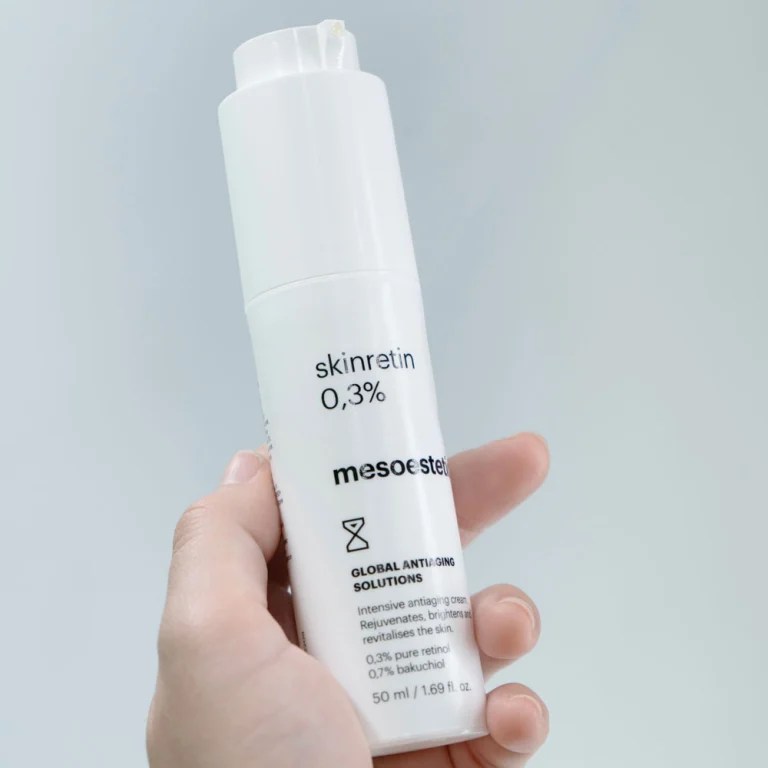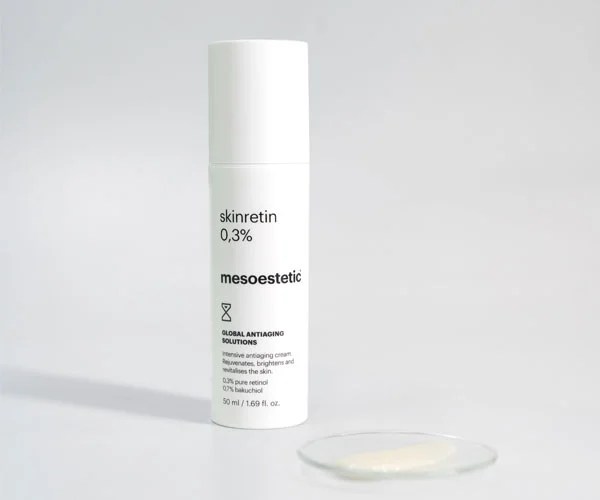The new retinol anti-ageing solution infused with bakuchiol

A derivative of vitamin A, retinol is widely renowned for its highly effective anti-ageing benefits. While you’re likely already well acquainted with its capabilities, it’s not the most straight-forward ingredient when it comes to incorporating it into your skincare routine.
Ahead, we introduce you to skinretin® 0.3%, a new retinol solution by mesoestetic® – a world leader in aesthetic and cosmetic medicine. Then, we dive into a few of the most common retinol questions.
Designed for at home-use, skinretin® 0.3% is an intensive skin revitalising solution to help improve the appearance of all signs of ageing. Backed by clinical and in vitro studies, the anti-ageing night treatment combines the power of 0.3% pure retinol and the gentle effectiveness of 0.7% bakuchiol. Together, the comprehensive formula helps visibly improve all signs of skin ageing, including dark spots, lack of luminosity, wrinkles and expression lines, and loss of firmness and elasticity.
Why bakuchiol?
The effects of retinol are enhanced when used in combination with bakuchiol, a natural active plant ingredient that has become widely known as an alternative to retinol. Bakuchiol provides very similar benefits to retinol, with the advantage of being ideal for sensitive skin that may be irritated and has a lower tolerance to retinoids.
skinretin® 0.3% is further enhanced with other active ingredients, such as a post-biotic complex (to visibly revitalise, balance and protect the skin’s microbiota), centella asiatica (which has a restorative effect) and ectoine (to help strengthen the skin barrier). With this composition, skinretin® 0.3% effectively helps visibly combat the signs of ageing for all skin types.
We asked Arantza Azparren, International Training Manager at mesoestetic®, to weigh in on all things retinol.

Arantza Azparren, International Training Manager at mesoestetic®
ProCollective (PC): Retinol has been around for a while, why do you think it’s so prevalent again now?
Arantza: Retinol is a vitamin A derivative that’s been improved over the years. In the past, due to the instability of its formula, retinol could cause irritation and tolerance issues in certain skin types. Thanks to new and innovative formulations, and production technologies, these problems of the past have been resolved and retinol has become one of the most popular anti-ageing active ingredients.
PC: For the uninitiated, how would you recommend they introduce retinol into their routine?
Arantza: Retinol is a very potent active ingredient and must therefore be used in the right way.
1. If you have never used retinol before, incorporate it into your skincare routine every other day for the first few weeks. Retinol can cause irritation if you start using it without the skin having undergone a ‘retinisation’ process or if the formula is too strong for you. If you are starting to use retinol, we recommend a low percentage formula (0.1% to 0.3%), applying a small pea-sized amount once or twice a week. Thereafter, gradually increase the amount to allow the skin to adapt until it is applied every night. Once the skin has managed to tolerate the product, you can consider the option of maximising the results by opting for a higher percentage.
2. Pay attention to possible skin responses. During the process of ‘retinisation’ of the skin, some common responses (such as mild irritation, dryness or flaking) may occur, which are quite normal. During this period when skin is adapting, pay attention to the skin’s response and look out for signs such as mild redness or flaking. People with sensitive skin should be especially cautious with the use of retinol and, depending on the case, use other, milder retinoids.
3. The time of application is at night.
4. Apply sunscreen every day. This should be broad spectrum and SPF50+. Retinol makes the skin particularly vulnerable to the sun’s rays, so wearing a high SPF sun protection is essential to avoid skin damage.

5. It is best to avoid introducing it to your skin at times of the year that involve a lot of direct exposure to the sun.
6. A simple moisturiser can be used before or after using the retinol product to prevent irritation and maintain skin hydration. In the morning, brighten your skins appearance with vitamin C products such as age element brightening cream or age element brightening concentrate, and protect against photoageing with a moisturising sunscreen with SPF50+ such as mesoprotech® light water antiaging veil.
PC: What actives should be avoided in the same application when using retinol?
Arantza: there are a few.
1. Vitamin C. If we combine retinol with vitamin C, we will be reducing the effectiveness of both products. This is due to a discrepancy between the pH at which these active ingredients are usually formulated: vitamin C is usually formulated at acid pH (3-3,5) to maximise its ability to penetrate the skin; however, retinol works best at a more neutral pH (around 5). It is recommended to apply vitamin C in the morning and retinol at night.
2. AHAs (alpha-hydroxy acids). Both AHAs and retinol act as exfoliants. If we combine them, we would be “over-exfoliating” and could cause significant irritation. If you want to use both active ingredients, it is advisable to use them every other night (as both should be applied at night). Some of the best known are glycolic acid, lactic acid and mandelic acid.
3. BHAs (beta-hydroxy acids). BHAs are sebum regulators, an example of which is salicylic acid, used in many anti-blemish products. This type of active ingredient can cause excessive dryness if mixed with retinol. They can be applied every other night or leave the BHAs for the mornings, without forgetting sun protection.
